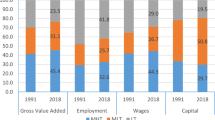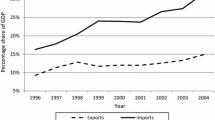Abstract
The paper examines the issues related to employment generation vis-à-vis export growth. The literature identifies that the relationship is complex and analysed individual dependency on factors such as labour intensity of production process, availability of skilled labour, technology integration and business cycle to drive or thwart higher employment. In this paper, we framed a dependency model and checked it empirically using Annual Survey of Industries (ASI) data from 2008/09–2015/16. The result reiterated the close relationship among these variables in determining the link between trade and employment. In India’s exporting industries, overall growth in employment is higher than the manufacturing sector as a whole; however, critical variations are seen with respect to the firm size and factor intensity. Potential to hire more workers decreases along with the rise in capital intensity and expansion of firm size as export goes up through productivity gain route. In general, productivity has a negative relationship with all types of employment unless external demand goes up. In labour-intensive industries due to slow technology integration, productivity gain is less and firms cover up this with more employment. Given the appropriate skill set and capital, SMEs have the greater potential to increase the exports and employment in the Indian economy, especially in favourable business cycle environment. Indian economy suffers right now from the lack of adequate skills that act as a hindrance in creating employment in large-scale firms. That is why large firms engage in substituting labour for capital.
Access this chapter
Tax calculation will be finalised at checkout
Purchases are for personal use only
Similar content being viewed by others
Notes
- 1.
Firm is defined as per the size. Small firms are the firms which hires less than 50 people, medium firms hire more than 49 but less than 250, and large firms hire more than 249 people.
- 2.
Log of all variables are considered in the equation.
- 3.
We have considered a Cobb–Douglas production function with inputs (capital, labour and material) to estimate the productivity.
- 4.
If an industry is exporting more than 15% of its ex-factory output, we have considered it an exporting industry.
References
Aho, C. M., & Orr, J. A. (1981). Trade-sensitive employment: Who are the affected workers? Monthly Labor Review, 104, 29–35.
Cornwell, C., Schmidt, P., & Sickles, R. C. (1990). Production frontiers with cross-sectional and time-series variation in efficiency levels. Journal of Econometrics. https://doi.org/10.1016/0304-4076(90)90054-W.
Das, D., Wadhwa, D., & Kalita, G. (2009). The employment potential of labor intensive industries in India’s organized manufacturing (No. 236).
Grossman, G. M., & Helpman, E. (1991). Trade, knowledge spillovers, and growth. European Economic Review. https://doi.org/10.1016/0014-2921(91)90153-A.
Hasan, R., Mitra, D., Ranjan, P., & Ahsan, R. N. (2012). Trade liberalization and unemployment: Theory and evidence from India. Journal of Development Economics. https://doi.org/10.1016/j.jdeveco.2011.04.002.
Kapoor, R. (2016). Technology, jobs and inequality evidence from India’s manufacturing sector (No. 313).
Kucera, D., Roncolato, L., & von Uexkull, E. (2012). Trade contraction and employment in India and South Africa during the global crisis. World Development. https://doi.org/10.1016/j.worlddev.2011.11.003.
Mehrotra, S., Parida, J., & Singh, S. G. A. (2014). Explaining employment trends in the Indian economy : 1993–94 to 2011–12. Economic & Political Weekly, XLIX, 49–57.
Milner, C., & Wright, P. (1998). Modelling labour market adjustment to trade liberalisation in an industrialising economy. Economic Journal. https://doi.org/10.1111/1468-0297.00301.
Nag, B. (2005). Impact of capacity utilisation and slow adjustments of Quasi-fixed factors on productivity and efficiency measurement: An experiment with Indian pharmaceutical industry. Journal of Pharmaceutical, Finance, Economics and Policy, 14, 69–73.
Orbeta, A.C. (2002). Globalization and employment: The impact of trade on employment level and structure in the Philippines. In PIDS Discussion Paper Series, No. 2002–04. Philippine Institute for Development Studies (PIDS), Makati City.
Rattsø, J., & Torvik, R. (1998). Zimbabwean trade liberalisation: Ex post evaluation. Cambridge Journal of Economics. https://doi.org/10.1093/oxfordjournals.cje.a013719.
Revenga, A. (1999). Employment and wage effects of trade liberalization: The case of Mexican manufacturing 15. https://doi.org/10.1596/1813-9450-1524
Srivastav, V. (1996). Liberalization productivity and competition: A panel study of Indian manufacturing. Oxford University Press.
Vashisht, P. (2015). Creating manufacturing jobs in India : Has openness to trade really helped? (No. 303).
Veeramani, C., Dhir, G. (2017). Reaping gains from global production sharing domestic value addition and job creation by Indian exports domestic value addition and job creation by Indian exports reaping gains from global production sharing, in: IARIW-ICIER conference.
Vivarelli, M. (2002). Globalisation, skills and within-country inequality in developing countries, in: Draft for ILO Project on understanding globalisation, employment and poverty reduction. Geneva: ILO.
Wagner, J. (2002). The causal effects of exports on firm size and labor productivity: First evidence from a matching approach. Economics Letters, 77, 287–292. https://doi.org/10.1016/S0165-1765(02)00131-3.
Acknowledgments
This chapter has been adapted from the authors’ working paper, ‘“India’s Trade Sensitive Employment Analysis at the Sectoral Level”’, July 2018, IIFT Working Paper No: EC-18-34, http://cc.iift.ac.in/research/Docs/WP/34.pdf
Author information
Authors and Affiliations
Corresponding author
Editor information
Editors and Affiliations
Appendix
Appendix
List of variables used in paper, necessary variables are deflated with WPI:
-
Capital (K): It is the capital stock. This we have calculated using the perpetual inventory accumulation following the idea proposed by Srivastava (1996) and Nag (2005). Model identifies the initial investment, constant growth rate of capital stock from the data of gross fixed capital and accumulated depreciation. To get capital, the net values closing of all the fixed assets of firms are taken, which includes land, building, transport equipment, plant and machinery, computer equipment including software, pollution control equipment, others and capital work in progress. It is provided in Block-C of ASI data set.
-
Labour (L): ASI provides the data in its Block-E regarding employment and labour cost. For this, it classifies labour as following:
-
1.
Female: Female workers employed directly
-
2.
Male: Male workers employed directly
-
3.
All directly employed: 1 + 2
-
4.
Contractual workers: Workers employed through contractors
-
5.
Supervisor workers: Supervisory and managerial staff
-
6.
All workers: 3 + 4 + 5 + unpaid family members/ proprietor/ coop. members + other employees.
-
1.
-
Wages (w): Wages/salaries (in Rs.) are given in Block-E of ASI data set for all types of workers discussed above.
-
Material (M): Stock of raw materials is used as input. Raw materials and components and packing materials are the variable used to calculate the stock of raw material, by taking its closing value difference from opening value. It is given in Block D of ASI which tells about the opening and closing balance of working capital and loans.
-
Output (Y): It is the output. Ex-factory value of output is given in the ASI data for each firm which is considered as output variable at current prices.
-
Accumulated depreciation (AD): As ASI reports the book value of the fixed assets, so, having difference between net and gross closing capital, we get the accumulated depreciation.
-
Depreciation (Dep): It is defined for time period t as follows: Dept = ADt+1 − ADt.
-
Gross fixed assets (GFA): It is defined with the gross closing value of all fixed assets.
-
Depreciation rate (δt): It tells the rate at which fixed assets are depreciated.
-
Investment (I): Investment in any time (t) is defined as the difference between gross capital closing and opening.
-
Total factor productivity (TFP): It is the share of output not expounded by the extent of inputs used in production.
Rights and permissions
Copyright information
© 2021 The Author(s), under exclusive license to Springer Nature Singapore Pte Ltd.
About this chapter
Cite this chapter
Nag, B., Khurana, S. (2021). India’s Trade-Sensitive Employment: A Comprehensive Firm-Level Analysis. In: Lakhanpal, P., Mukherjee, J., Nag, B., Tuteja, D. (eds) Trade, Investment and Economic Growth. Springer, Singapore. https://doi.org/10.1007/978-981-33-6973-3_13
Download citation
DOI: https://doi.org/10.1007/978-981-33-6973-3_13
Published:
Publisher Name: Springer, Singapore
Print ISBN: 978-981-33-6972-6
Online ISBN: 978-981-33-6973-3
eBook Packages: Economics and FinanceEconomics and Finance (R0)




